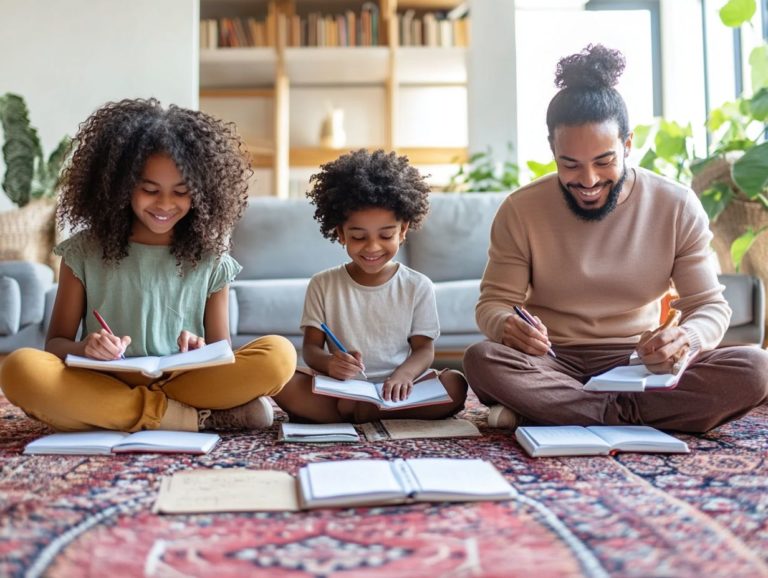How to Create a Mindfulness Calendar for Kids
In today s fast-paced and busy world, instilling mindfulness in children is more crucial than ever for their emotional and mental well-being. A mindfulness calendar presents an enjoyable and engaging way to introduce children to practices that foster awareness, gratitude, and relaxation.
Here are ten practical steps to create a mindfulness calendar that will capture young minds while nurturing essential habits. From themed activities to outdoor explorations and opportunities for family involvement, explore how to seamlessly integrate mindfulness into your child s daily routine, transforming it into a joyful experience.
- Key Takeaways:
- 1. Set a Theme for the Mindfulness Calendar
- 2. Include Daily Mindful Activities for Children and Adults
- 3. Incorporate Fun and Interactive Activities for Social-Emotional Learning
- 4. Encourage Reflection and Gratitude for Personal Growth
- 5. Include Mindful Eating Habits for Emotional Development
- 6. Schedule Regular Mindfulness Exercises for Mental Health
- 7. Include Outdoor Activities for Emotional Support
- 8. Add Mindful Art and Craft Activities for Creativity
- 9. Include Mindful Breathing Exercises and Positive Affirmations
- 10. Encourage Family Participation
- Why Is Mindfulness Important for Kids?
- How Can Parents Incorporate Mindfulness into Their Child’s Daily Routine?
- What Are Some Tips for Creating a Successful Mindfulness Calendar?
- How Can Mindfulness Help with Children’s Mental Health and Well-Being?
- What Are Some Fun and Creative Ways to Teach Mindfulness to Kids?
- Frequently Asked Questions
- 1. What is a mindfulness calendar for kids?
- 2. Why is it important to create a mindfulness calendar for kids and adults?
- 3. How can I create a mindfulness calendar for kids and adults?
- 4. What are some examples of mindfulness activities to include in a calendar for kids?
- 5. How can I make the mindfulness calendar interactive for kids?
- 6. Can I involve my child in creating the mindfulness calendar?
- Set a theme to make the calendar engaging and relatable for children.
- Incorporate daily mindful activities that suit their age and interests.
- Include fun activities to keep children excited about practicing mindfulness.
Contents
Key Takeaways:
1. Set a Theme for the Mindfulness Calendar
Setting a theme for your mindfulness calendar is a crucial step in focusing on feelings and emotions and creating an environment ripe for personal growth, whether for yourself, your children, or both. This theme can center around significant concepts like gratitude, positive affirmations, or overall well-being, establishing routines that benefit your family and educational settings alike. By aligning daily activities and reminders with your chosen theme, you can ensure a consistent emphasis on mindfulness, which supports emotional awareness and encourages quality time together. Teachers can also integrate these themes to foster social-emotional learning in the classroom.
When selecting a theme, think about what resonates most with your family dynamics. For example, fostering a gratitude mindset can inspire both children and adults to reflect on daily positives and cultivate a culture of appreciation.
Emotional support can shine through activities like shared journaling or weekly check-ins. These not only enhance communication but also strengthen the bonds within your family while contributing to better work-life balance, providing structured time management solutions for busy parents.
Incorporating activities such as guided meditations (which are practices that help focus the mind) or family yoga sessions can be tailored to engage both children and adults, creating shared experiences that empower everyone involved.
Ultimately, your chosen theme should open doors for connection, introspection, and growth, transforming mindfulness into a family affair. This can also foster new beginnings and create a gratitude mindset.
2. Include Daily Mindful Activities for Children and Adults
Incorporating daily mindful activities into your calendar is essential for helping children understand their feelings and fostering a positive mindset for both children and adults. These activities can be easily tracked using a calendar template.
These activities can be as simple as meditation practices, engaging breathing exercises, or even reflective journaling sessions. For example, setting aside just five minutes each day for deep breathing can be incredibly beneficial. You might try counting your breaths or visualizing a tranquil space to help ground yourself. Using daily journaling prompts helps maintain consistency.
Families can also come together for a brief group meditation, creating a shared moment of peace. Meanwhile, individual journaling allows for personal expression and introspection. To keep things enjoyable and engaging for children, encourage them to use colorful pens or stickers in their journals, transforming the experience into something interactive and fun.
By establishing a routine that seamlessly blends these mindful practices into daily life, you can help both children and adults develop a deeper connection with their thoughts and emotions, ultimately promoting a sense of tranquility and balance. This practice also enhances mental presence and self-reflection.
3. Incorporate Fun and Interactive Activities for Social-Emotional Learning
Incorporating fun and interactive activities into your mindfulness calendar can significantly elevate engagement and spark creativity, particularly among children and families!
Try fun activities like hands-on art projects that encourage self-expression, nature walks that inspire a sense of wonder while connecting with the environment, or group games designed to enhance cooperation and empathy. By participating in these enriching experiences, children not only develop emotional awareness but also contribute to creating a supportive family atmosphere.
For instance, collaborative art projects foster open conversations about feelings. Meanwhile, nature walks offer opportunities for reflection and bonding. Including technology breaks in your schedule can also enhance these experiences.
Ultimately, these shared moments are vital for nurturing resilience and strengthening relationships, laying a solid foundation for emotional intelligence and healthy communication within your family.
4. Encourage Reflection and Gratitude for Personal Growth
Encouraging daily reflection and gratitude is essential for enhancing mindfulness practices and fostering emotional support for both children and adults.
By weaving structured activities into your calendar, you can help everyone appreciate more and gain emotional insight within your family. Daily journaling prompts can be a powerful tool, allowing for moments of pause to consider your experiences and feelings.
Engaging in gratitude exercises, such as identifying three things you re thankful for each day, can dramatically shift your perspective, unveiling the abundance present in your life. Family discussions that revolve around reflections on the day foster open dialogues, creating an environment where emotional awareness flourishes.
Together, these practices enhance well-being and resilience, enriching your personal growth and strengthening family bonds. They also help children build support systems that last a lifetime.
5. Include Mindful Eating Habits for Emotional Development
Integrating mindful eating habits into your mindfulness calendar can create a comprehensive approach to well-being, enhancing emotional development for both children and adults. These habits can also be taught and reinforced at school to support students in developing lifelong healthy practices.
This practice invites you to be fully engaged during meals, focusing not just on the delightful flavors and textures of your food but also tuning into your internal responses and feelings. To weave mindful eating into your daily routines, consider establishing regular meal times where conversations can flow freely, allowing everyone to share their thoughts and emotions.
Engaging in simple activities, such as preparing meals together or discussing the origins of your ingredients, can significantly deepen your connections. By turning off screens and minimizing distractions during meals, you create an atmosphere for open dialogue.
Encouraging these discussions transforms meals into a platform for sharing experiences, promoting healthier choices, and nurturing a supportive environment that values both health and emotional awareness.
6. Schedule Regular Mindfulness Exercises for Mental Health
Scheduling regular mindfulness exercises, like meditation and yoga, into your calendar fosters emotional awareness and nurtures a healthy mindset, benefiting both children and adults alike. These practices are effective in addressing challenges and building resilience.
In our fast-paced world, weaving these practices into your daily routine can significantly boost your emotional resilience and overall well-being. For instance, dedicating just five minutes each morning to a brief breathing exercise can ground you and set a positive tone for the day ahead!
Engaging in mindfulness activities, like a quick body scan or mindful walking during your lunch break, affords you invaluable moments of reflection that can break the cycle of stress.
Embracing mindfulness apps offers guided sessions that seamlessly fit into your schedule, making it easier to cultivate a habit that ultimately enhances your mental health.
7. Include Outdoor Activities for Emotional Support
Incorporating outdoor activities into your mindfulness calendar is crucial for enhancing emotional support and well-being, especially for children who flourish in natural settings. These activities also provide opportunities for kindness and responsibilities, further aiding in their social-emotional learning.
Engaging with the outdoors provides a remarkable opportunity for you and your family to connect with your surroundings and one another. Nature walks can be a tranquil way to practice mindfulness, allowing both you and your children to savor the beauty around you while fostering a sense of calm.
Gardening activities not only offer an excellent form of exercise but also cultivate a sense of responsibility and accomplishment in kids. Playing outdoor games encourages teamwork and strengthens family bonds, promoting effective communication and collaboration.
By embracing these diverse outdoor pursuits, you ultimately support physical health, emotional growth, and deeper connections within your family.
8. Add Mindful Art and Craft Activities for Creativity
Incorporating mindful art and craft activities into your calendar can truly unlock creativity and serve as a powerful catalyst for emotional development, whether for children or adults. These art activities can be introduced in both family settings and educational environments to foster emotional support.
By engaging in activities like painting, you can explore your feelings through color and form, allowing for personal expression that is both liberating and enlightening. Collage-making takes it a step further, inviting you to assemble an array of materials that fosters a sense of individuality and ownership over your creation. Using resources from platforms like Twinkl can also provide inspiration and guidance for these activities.
Sculpture offers a hands-on experience that can be especially therapeutic, giving you the chance to mold your thoughts and emotions into something tangible. These artistic endeavors not only promote relaxation and focus but also cultivate deeper emotional connections within your family. They create a shared space where you can discuss feelings and experiences while crafting something meaningful together. Additionally, you can integrate art activities to further enhance emotional expression.
Ultimately, embracing these mindful practices can enhance your overall well-being and fortify the bonds you share with your loved ones, including quality time spent with family and children.
9. Include Mindful Breathing Exercises and Positive Affirmations
Incorporating mindful breathing exercises and positive affirmations into your daily calendar can significantly enhance your emotional awareness and overall well-being, whether you re a child or an adult. These practices act as a simple yet powerful tool, allowing you to pause and breathe amidst the whirlwind of everyday life.
Consider trying deep belly breathing: inhale slowly through your nose, letting your abdomen expand fully, and then exhale gently through your mouth. Another effective technique is the 4-7-8 method, where you inhale for four seconds, hold your breath for seven, and exhale for eight seconds. This method promotes relaxation and helps reduce anxiety. Additionally, integrating yoga into your routine can further enhance relaxation and emotional balance.
By weaving these exercises into your daily routines say, during a short work break or just before bedtime you can cultivate a deeper sense of calm. This small adjustment can have a profound impact on managing stress and fostering emotional balance throughout your life. It’s important to set reminders to practice these exercises regularly.
10. Encourage Family Participation
Encouraging your family to participate in mindfulness practices can truly elevate emotional support and strengthen the bonds among family members. When everyone joins in these activities, it opens the door for shared experiences that nurture understanding and empathy within the family. This participation also fosters skills for understanding and managing emotions and mutual emotional support.
Consider incorporating simple yet impactful practices, such as:
- guided family meditation sessions.
- Nature walks where you can all focus on sensory experiences.
- Cooking together mindfully taking the time to appreciate each ingredient.
- Engaging in daily journaling sessions together to reflect on the day’s activities and emotions.
These shared moments provide a platform for individuals to express their feelings freely, fostering deeper connections.
Establishing a routine around mindfulness cultivates a sense of togetherness, enhancing the family’s resilience and emotional awareness. Ultimately, investing time in these practices can lead to enriched relationships and create a more harmonious home environment. Consider using a calendar template to schedule these activities.
Why Is Mindfulness Important for Kids?
Mindfulness is essential for children as it enhances emotional development, supports mental health, and fosters vital skills for understanding and managing emotions, laying the groundwork for lifelong well-being and promoting beneficial mindset shifts.
Research demonstrates that by incorporating mindfulness practices like deep breathing and guided meditation children can effectively navigate challenges and improve their emotional regulation. For instance, a study published in the Journal of School Health revealed that students who engaged in mindfulness activities reported lower anxiety levels and heightened focus in their academic pursuits. This can be particularly beneficial in the classroom environment, enhancing both learning outcomes and peer relationships.
Educators consistently share testimonials about how children who practice mindfulness exhibit greater resilience when faced with stressors, leading to a more positive mindset. Over time, these practices not only cultivate a sense of calm but also nurture empathy and compassion, equipping children with essential tools to approach life s ups and downs with a balanced perspective. This also fosters personal growth and emotional intelligence.
What Are the Benefits of a Mindfulness Calendar for Kids?
A mindfulness calendar presents a wealth of benefits for children, fostering their emotional development, enhancing daily routines, and cultivating an awareness of personal growth opportunities. This tool can help guide time management and set positive habits.
By actively engaging with the calendar, your child can learn to identify and articulate their feelings, which is essential for developing emotional intelligence. For instance, they might draw a smiley face for happy days and a sad face for tough days. When they mark a day they felt happy or sad, they begin to grasp their emotional patterns, providing invaluable insights into their inner world. Not only does this practice encourage self-reflection, but it also opens the door to deeper personal insights!
Incorporating mindfulness practices into their daily agenda can significantly enhance their focus during tasks like homework or chores. As they learn to manage distractions and remain present, you ll likely see your child tackle assignments with amazing focus. This can also improve their time management skills.
A mindfulness calendar encourages the formation of positive habits, such as gratitude and kindness. You ll likely see these qualities blossom in actions like sharing with friends or expressing appreciation at home, creating a ripple effect of positivity in their environment. This practice can also incorporate daily journaling of positive affirmations.
How Can Parents Incorporate Mindfulness into Their Child’s Daily Routine?
Start today to weave mindfulness into your child’s daily routine by introducing simple practices that nurture emotional awareness and well-being, even amidst your busy schedules.
By integrating brief moments of reflection during transitions such as moving from school to home you create a welcoming space for your child to express their feelings and thoughts. Establish gentle reminders throughout the day, like setting aside a specific time to pause for breathing exercises. This helps instill a sense of calm in your household.
Transform family activities, such as cooking together or enjoying nature walks, into opportunities for connection and being present. Encourage your child to observe their surroundings and share their experiences. This will strengthen their mindfulness practice and nurture emotional resilience as they grow.
What Are Some Tips for Creating a Successful Mindfulness Calendar?
Creating a successful mindfulness calendar requires thoughtful planning and a keen eye for activities that nurture emotional growth while blending seamlessly into your family s routines.
Start by selecting engaging themes for each month or week think gratitude, stress relief, or nature appreciation that will shape the activities you choose to include. Consider themes such as new beginnings in January and social-emotional learning (the way we understand and manage emotions and learn to interact with others) in February. Aim for a diverse array of practices, ranging from meditation and journaling to invigorating outdoor family walks or creative arts, ensuring that there s something for everyone to connect with.
It’s also beneficial to involve your family members in the planning process. This boosts their commitment and allows you to cater to various preferences and interests. Remember to embrace flexibility in your scheduling; adapting activities to fit the family s availability can foster greater participation and enhance the enjoyment of your collective mindfulness journey. Utilizing a calendar template can help streamline this process.
How Can Mindfulness Help with Children’s Mental Health and Well-Being?
Mindfulness plays a crucial role in enhancing your child’s mental health and well-being by giving them the skills to support their emotions and fostering vital social-emotional learning skills. It also contributes significantly to their overall emotional development.
By incorporating mindfulness practices into their daily routine, your child can experience significant stress reduction, enabling them to navigate the pressures of school and social interactions with greater ease. Research shows that regular mindfulness exercises improve emotional regulation, helping them identify and manage their feelings more effectively.
A study published in the journal ‘Mindfulness’ revealed that students who practiced mindfulness exhibited reduced anxiety and improved attention spans. Incorporating technology breaks can also help alleviate stress and improve mental presence.
Experts also highlight that these coping strategies benefit your child’s individual well-being and enhance the classroom environment, leading to better peer relationships and overall school performance. This positively contributes to their educational journey and personal growth.
What Are Some Fun and Creative Ways to Teach Mindfulness to Kids?
Teaching mindfulness to kids can be an enjoyable and imaginative experience, filled with engaging activities that ignite their creativity while nurturing their emotional growth.
By weaving in storytelling, you can transport children into enchanting tales that highlight the principles of mindfulness in a way that resonates with them. This allows them to reflect on their own emotions and thoughts. Consider incorporating games focused on mindful practices think nature scavenger hunts or mindful breathing exercises which inject excitement and foster teamwork, transforming learning into a delightful adventure. You can also set daily prompts that encourage kids to practice mindfulness routines.
Let s unlock their creativity with fun art projects, such as creating mandalas or expressing emotions through painting, which offer perfect opportunities for self-expression while reinforcing focus and tranquility. These innovative approaches not only help children grasp the concepts of mindfulness but also cultivate a joyful learning environment that encourages exploration and connection. Consider integrating creative activities into their daily routines to make mindfulness engaging and fun.
Frequently Asked Questions
1. What is a mindfulness calendar for kids?
A mindfulness calendar for kids is a visual tool that helps children incorporate mindfulness practices into their daily routine.
It typically consists of a calendar with daily prompts or activities that promote mindfulness and well-being. These calendars can also include positive affirmations and exercises to encourage a gratitude mindset.
2. Why is it important to create a mindfulness calendar for kids and adults?
Creating a mindfulness calendar for kids is a fantastic way to help them thrive! It helps children develop a daily mindfulness habit, which can offer numerous benefits for their mental and emotional well-being, including emotional skills and learning how to interact with others.
It also encourages them to slow down, be present, and practice self-care, fostering a positive mindset.
3. How can I create a mindfulness calendar for kids and adults?
To create a mindfulness calendar for kids, gather a blank calendar template, colored pencils or markers, and a list of mindfulness activities suitable for children.
These activities can include art projects, breathing exercises, and yoga. Then, assign a different activity for each day of the month and decorate the calendar together to make it fun and engaging. Consider adding reminders to help them stay consistent with their mindfulness routines.
4. What are some examples of mindfulness activities to include in a calendar for kids?
Examples of mindfulness activities that can be included in a calendar for kids are gratitude journaling, daily journaling, deep breathing exercises, mindful coloring, guided meditations, nature walks, and yoga.
It is important to choose activities that are age-appropriate and enjoyable. These mindfulness activities also support emotional awareness and reflection.
5. How can I make the mindfulness calendar interactive for kids?
You can make the mindfulness calendar interactive for kids by including fun stickers and encouraging them to draw their own pictures for each day.
Additionally, adding a reward system for completing the activities will make the calendar more engaging and motivating for them, promoting personal growth and a sense of responsibility for their well-being. Incorporating prompts for activities can also add structure and enhance their mental presence.
6. Can I involve my child in creating the mindfulness calendar?
Absolutely! Involving your child in creating the mindfulness calendar makes it more personalized and enjoyable for them.
This approach gives them a sense of ownership and responsibility. Plus, it can be a fun bonding activity, fostering quality time and family connection. You can also use this opportunity to discuss the importance of mental health, the benefits of a gratitude mindset, and how to manage challenges in a busy world.



